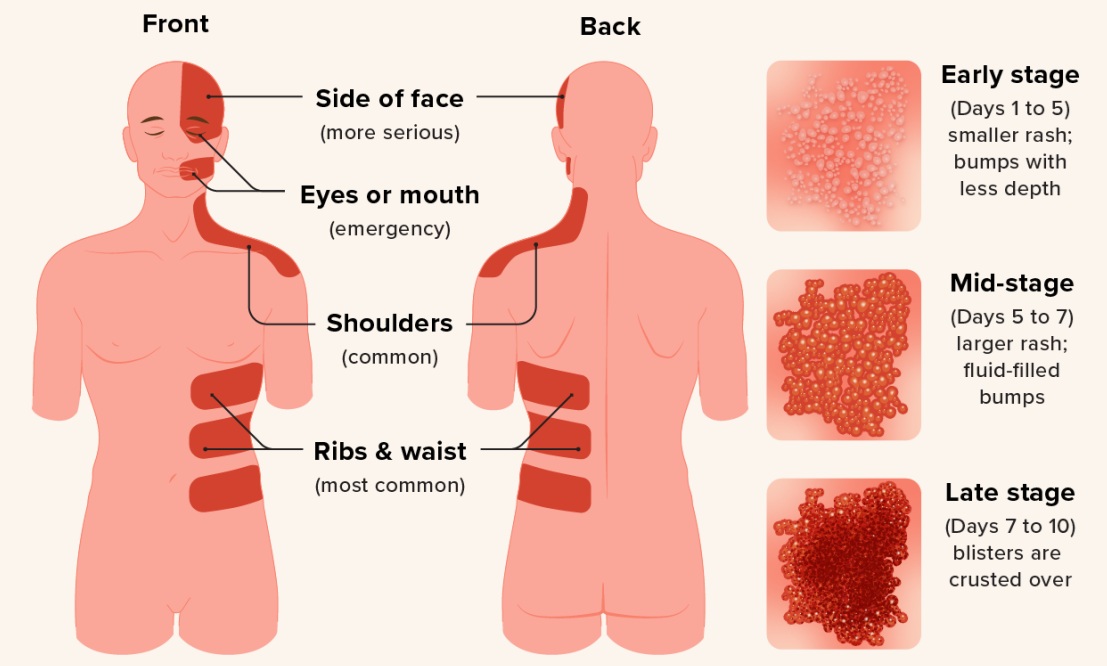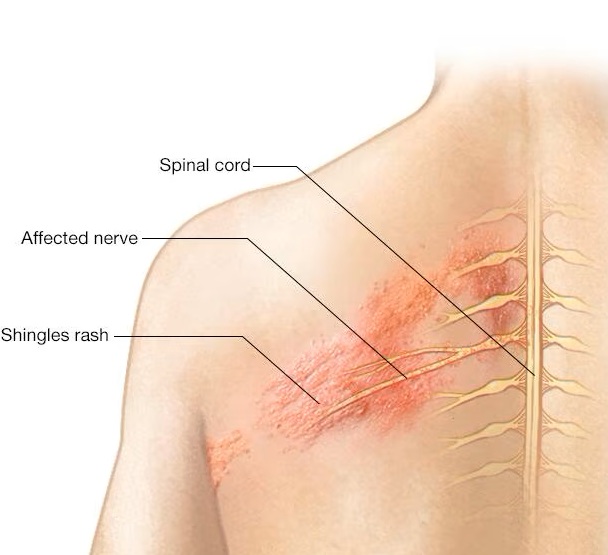Shingles
Shingles is a painful rash caused by the Varicella-Zoster Virus (VZV), the same virus that causes chickenpox. Varicella-zoster is part of a group of viruses called herpes viruses. It occurs when the virus reactivates in the body after a person has had chickenpox.
Shingles

Shingles is a viral infection that causes a painful rash. Shingles can occur anywhere on your body. It typically looks like a single stripe of blisters that wraps around the left side or the right side of your torso.
After you’ve had chickenpox, the virus stays in your body for the rest of your life. Years later, the virus may reactivate as shingles.
Shingles isn’t life-threatening. But it can be very painful. Early treatment may shorten a shingles infection and lessen the chance of complications. The most common complication is postherpetic neuralgia. This is a painful condition that causes shingles pain for a long time after your blisters have cleared.
Causes of Shingles
Shingles is caused by the varicella-zoster virus the same virus that causes chickenpox. Anyone who’s had chickenpox may develop shingles. After you recover from chickenpox, the virus enters your nervous system and stays inactive for years.
Sometimes the virus reactivates and travels along nerve pathways to your skin producing shingles. But not everyone who’s had chickenpox will develop shingles.
The reason for shingles is unclear. It may be due to lowered immunity to infections as people get older. Shingles is more common in older adults and in people who have weakened immune systems.
Varicella-zoster is part of a group of viruses called herpes viruses. This is the same group that includes the viruses that cause cold sores and genital herpes. As a result, shingles is also known as herpes zoster. But the virus that causes chickenpox and shingles isn’t the same virus that causes cold sores or genital herpes, which is a sexually transmitted infection.
Symptoms of Shingles
Burning or tingling Painful, Itchy, or Tingly rash on one side of the body, Usually around the abdomen.
Pain is usually the first symptom of shingles. For some people, the pain can be intense. Depending on the location of the pain, it can sometimes be mistaken for problems with the heart, lungs or kidneys. Some people experience shingles pain without ever developing the rash.
Shingles symptoms usually affect only a small section on one side of your body.
Sensitivity to touch
A red rash that begins a few days after the pain
Fluid-filled blisters that break open and crust over
Itching
Some people also experience in Shingles
Fever, Chills, Headache, Tiredness, Sensitivity to light, Fatigue, Enlarged lymph nodes
Complications of Shingles

Postherpetic neuralgia
Long-term nerve pain called postherpetic neuralgia (PHN).For some people, shingles pain continues long after the blisters have cleared. This condition is known as postherpetic neuralgia. It occurs when damaged nerve fibers send confused and exaggerated messages of pain from your skin to your brain.
Vision loss
Shingles in or around an eye (ophthalmic shingles) can cause painful eye infections that may result in vision loss.
Neurological problems
Shingles may cause inflammation of the brain (encephalitis), facial paralysis, or problems with hearing or balance.
Skin infections
If shingles blisters aren’t properly treated, bacterial skin infections may develop.
Contagiousness and Not contagious, but you can catch chickenpox from someone with shingles if you have direct contact with fluid from their rash
Risk factors of Shingles
Age, weakened immune system, having had chickenpox before age 1
Age
The risk of developing shingles increases with age. Shingles typically occurs in people older than 50. And people over the age of 60 are more likely to experience more-severe complications.
Some diseases
Diseases that weaken your immune system, such as HIV/AIDS and cancer, can increase your risk of shingles.
Cancer treatments
Radiation or chemotherapy can lower your resistance to diseases and may trigger shingles.
Some medications
Drugs that prevent rejection of transplanted organs can increase your risk of shingles. Long-term use of steroids, such as prednisone, may also increase your risk of developing shingles.
Treatment for Shingles
There is no immediate cure, but the rash usually clears up within 2 to 4 weeks
Shingles is most common in people over age 50, but anyone who has had chickenpox can get it.
medlight2u.com
A light on Practice of Medicine (The information provided is for informational and educational purposes only and should not be considered professional advice)
- Sleeplessness (insomnia)
- Furuncle Nostril
- Presbyopia meaning “old eye”
- Oral cancer
- Gestational Trophoblastic Neoplasia (GTN)
Acne Acne vulgaris Acute Renal Failure Adrenal cortex Angina Angina Pectoris Aortic Regurgitation (AR) Aortic Stenosis (AS) Chest pain Chronic pyelonephritis Coarctation of Aorta Cough cyanosis Cystic acne Dehydration depression Diabetes Mellitus Diagnosis of Aortic Stenosis Dr.KTS DR K TAMILSELVAN Fatigue Heart Failure Hypertension Hypokalemia Hypothyroidism Ischemic Heart Disease LBBB Mitral Incompetence Mitral insufficiency Mitral valve prolapse Nocturia Patent Ductus Arteriosus PDA Polyuria Proteinuria pulmonary hypertension Pulmonary Stenosis ST Depression Symptoms of Acne Syncope Treatment for acne valvular heart disease Ventricular Septal Defect VSD Zits


Leave a Reply